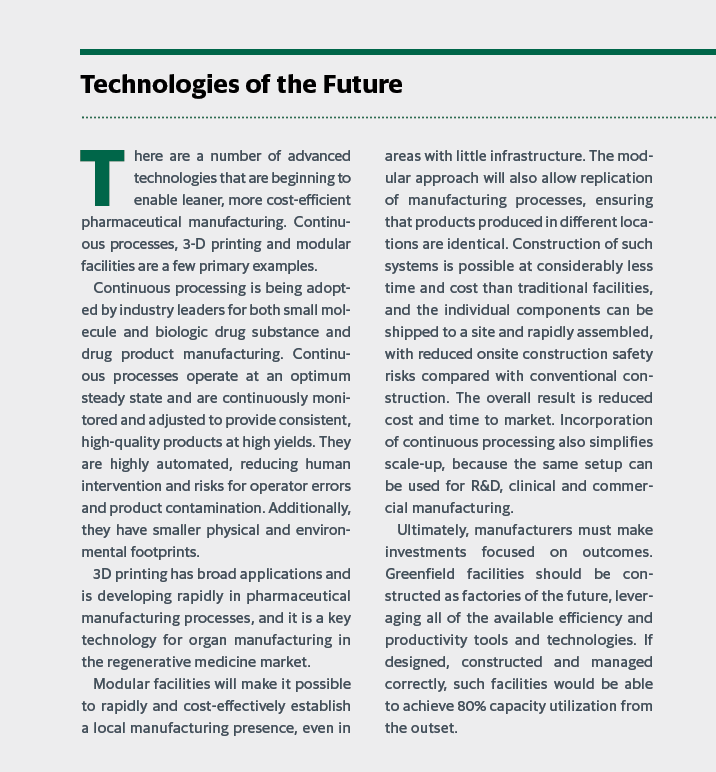With capacity utilization in the pharmaceutical industry at a surprisingly low rate, drug makers are rationalizing facilities and contract supply networks to gain efficiencies and reduce cost. The new contract development and manufacturing organization (CDMO) TriRx Pharmaceutical Services was formed to help pharma customers reach their goals by providing integrated contract development and manufacturing services across the full development and manufacturing continuum, supported by exceptional service.
The Capacity Utilization Conundrum
The pharmaceutical industry currently faces a significant issue: poor capacity utilization rates. Compared with the consumer products industry, where true capacity utilization rates are maintained above 85%, utilization of existing pharmaceutical manufacturing capacity across the entire industry network hovers near 30–35%.
The actual utilization rate is difficult to definitively determine, because companies calculate capacity utilization in different ways on the basis of individual criteria and assumptions. Truly, capacity utilization should be calculated based on the full potential capacity of a plant, which includes all of the possible shifts and operating lines running 24/7 (or at least 24/5), because the equipment is available for use every hour of each day.
Unfortunately, 100% utilization is most typically determined based on the current state of operations. A company running two shifts, five days per week will consider that full capacity, rather than running three shifts, five or seven days per week.
By taking this approach, many manufacturers choose to expand capacity when doing so is not required. In general, companies establish a capacity utilization rate, above which they deem it essential to add additional capacity. If the assumptions used to determine that utilization rate are inaccurate, investment in additional equipment and facilities can occur when those expenditures are not yet needed. A facility running two shifts per week can add another five to eight operators and run an additional shift rather than invest in a new process line, saving significant CapEx, accelerating the rate of expansion and preventing underutilization.
The pharmaceutical industry must learn from other sectors, such as the consumer products industry, that have achieved high capacity utilization rates and lean manufacturing solutions.
The Demand for Greater Efficiency
Another factor contributing to the present low capacity utilization rate in the pharmaceutical industry is the high level of inefficiency of many facilities and processes. In general, the batch approach to manufacturing is inefficient, because it requires a very large footprint and expensive equipment, much of which sits idle while specific unit operations are completed.
Many older pharmaceutical production processes also tend to be inefficient, because, at the time they were initially designed, the main driver was speed and the need for boosting efficiency and productivity was not as critical. Manufacturing processes often deliver the desired product at 70% yield or less. Most small molecule production requires multiple steps, so poor yields are magnified throughout the entire process. Increasing the yield to 80–90% enables the manufacturer to obtain more product with the same equipment over the same time period. Utilization of Lean and Six Sigma tools can have a tremendous impact on efficiency and productivity improvements and can significantly increase capacity utilization.
Increasing productivity should be considered for all activities in a pharmaceutical production facility, from raw material testing to packaging. Each process should be comprehensively mapped, and then each step/unit operation/activity must be challenged to clearly understand what is restricting the ability to increase efficiency and productivity. If the packaging process is found to be critical, for example, then capacity could be increased by adding a second packaging line or limiting a piece of equipment and running them in parallel. The overall result would be increased capacity for the entire process, with investment and expansion only where it is actually needed.
Achieving Cost Improvement
Annual revenues for the global pharmaceutical industry are approximately $1 trillion. The cost of goods (COGS) for the entire industry averages approximately U.S. $250 billion — about 25% of revenues. The potential opportunity to reduce COGS by implementing efficiency and productivity improvements is somewhere in the neighborhood of 10% — which could reduce COGS by about $100 billion per year!
Reducing COGS in this manner will enable pharmaceutical companies to be more cost competitive and to realize a fair profit.
The pharmaceutical industry must learn from other sectors, such as the consumer products industry, that have achieved high capacity utilization rates and lean manufacturing solutions. Manufacturers must take the best practices demonstrated in these other production environments and translate them into effective solutions for the pharmaceutical business. Investment in Lean Six Sigma tools, application of automation process control and robotics and utilization of new technologies will yield significantly increased efficiencies and productivity.
Need for Delivery Performance
The need to improve capacity utilization and increase productivity and efficiency are particularly important for CDMOs. Customers want delivery on time and in full at a fair price. They also want their products to comply with regulatory requirements. Accomplishing these goals requires excellent process control, such that all processes are reliable, repeatable and sustainable. Only under these conditions is it possible to commit to and meet a schedule and ensure optimal delivery 100% of the time.
Unfortunately, few CDMOs are successful in this respect. While many pharmaceutical companies choose to partner with and rely heavily on service providers, they often say that their reliance on CDMOs is among the biggest challenges of their business. When outsourcing partners do not deliver on time and in full, the sponsor firm’s supply chain is put at risk. Fortunately, CDMOs perform well most of the time. When they do not, however, it can be a major problem.
3D Printing has broad applications and is developing rapidly in the pharmaceutical manufacturing processes and is key to organ manufacturing in the regenerative medicine market.
Supplier Consolidation
The industry’s low capacity utilization rate also impacts the types of CDMOs with whom pharma companies want to partner. Innovator companies are often focused on rationalizing their manufacturing networks to increase their internal capacity utilization, and doing so creates a need to outsource some products. Rather than add to their complex supply networks, however, sponsors are also looking to rationalize their suppliers.
Most large pharma companies have approximately 500 suppliers. Many want to reduce that number to between 75 and 100 in order to reduce the time, cost and resources needed to manage their outsourcing partners.
CDMOs that can manufacture both drug substances and drug products, including a wide range of dosage forms (e.g., liquid, solid, inhalation, sterile) for both small molecule and biologic formulations are therefore receiving significant attention. These integrated, global CDMOs can help sponsor firms sustain their rationalization efforts by producing a wide range of products and delivering them to every major market in the world.
Building A Better CDMO
TriRx Pharmaceutical Services was founded to meet the need for integrated CDMOs that can consistently and reliably deliver. We have established a company with the expert staff, facilities, equipment, capabilities and experience necessary to function as the manufacturing arm of sponsor organizations.
Unlike CDMOs that are owned by private equity firms with short-term goals, we recognize that pharmaceutical manufacturing is a long-term business that requires long-term investment and commitment. We also recognize that quality is critical and are willing to invest in the people, processes and equipment needed to meet or exceed regulatory requirements in all of the markets that we serve.
We are building TriRx via the acquisition of high-quality facilities with long histories of making quality products, extensive track records with respect to compliance and delivery and transparent cost structures. As each new facility is acquired, it is integrated into a single, cohesive company through the implementation of standardized systems, processes and procedures.
Our team of pharmaceutical industry executives have served as both contract service providers and customers. They have held a range of positions, from working on the plant floor to the executive suite. Our diverse staff ensures that TriRx has a deep and multifaceted understanding of our evolving customers needs. Our goal is to be recognized as a CDMO that consistently meets those requirements and to be viewed by pharma companies as a critical component of their supply chains.
Within five years, TriRx will comprise six to 10 facilities covering drug substance and drug product for small and large molecule products in all relevant dosage forms.
Aggressive Growth Plans
Headquartered approximately 50 miles outside of New York City in Norwalk, Connecticut, TriRx is building a network of facilities with state-of-the-art laboratory, manufacturing, packaging and warehousing capabilities.
Our first manufacturing site (Huntsville, Alabama) is a best-in-class facility for the production of liquids (solutions, suspensions and colloidal dispersions), creams, ointments and lotions. It is a proven industry leader in liquid and semisolid manufacturing and packaging that is also capable of handling controlled substances (CII – CV), with vault and cage storage on site. The facility is serialization-ready, with Optel Line Equipment and TraceLink Level 4 Solution online.
Currently, TriRx is exploring other potential acquisition in the solid dosage, large molecule, sterile processing and animal health spaces. Negotiations are underway for facilities in each of these areas, and we expect to close on two of the four deals within the next six months.
Within five years, TriRx will comprise six to 10 facilities covering drug substance and drug product for small and large molecule products in all relevant dosage forms. By that time, we project that we will be generating revenues approaching $500 million annually.

